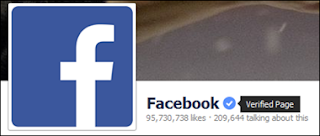
Facebook recently introduce new feature to show that a page or profile is verified or not. As a normal Facebook user we all create account or page with our name and it is also possible to create multiple account on same name. Their are number of same name pages or account for any celebrity, public figure or for any business. So Facebook take serious step to make clear that which one is official and all the rest of others are not. This verification show that the page or profile your are visiting official represent someone or maybe a property of anybody.
What is Verified Profile or Page ?
According to this new option some pages and Profiles are claim as Official and verified by Facebook. You may observe on many profiles and pages their is Blue Color Tick Badge just in the next of name.  Facebook only four type of pages or profiles which are
Facebook only four type of pages or profiles which are
- Celebrities
- Journalists
- Government Officials
- Popular Brand or Businesses
These are four categories whose pages and profiles are claimed by Facebook based on their popular. Suppose if you have any local business which is popular then Facebook may claimed your page if you are official representative. Then their is no need to submit any type of request to Facebook. They automatically claim your page as verified depend on some details and minimum requirements mention by Facebook.
How To Get Verified ?
If your profile or any Page whose your are official representative and also based on above mention categories then their are chances of your page to get verified. Actually Facebook does not have any request form to claim verified this is totally automatic process done from Facebook side. So to become verified in future you should have to do some changes in your Profile or Page
- Your page should be official represent your local business or any personality and may be have some popularity on Facebook.
For Facebook claiming process your page or profile must have minimum details because if you add full details accurately then Facebook automatically check your provided information if they find your page or profile details accurate and helpful then verify your page here are two parts mention by Facebook to become verified
- Link To Your Profile or Page From Official Website and also link website on your page or profile.
- Provide accurate information in details about your business in About Section of Page or Profile
In About section must add significant long and short description, keyword who represent your business, Email, Website, Products and verified page location with claimed business address and other details in Page Info tab. Just for example as shown below
For more details visit help center here for Profile or Page About info.
These are some tips which help you to get verified if your profile or page is official. Facebook don't guaranteed about all pages to get verified because its totally depend on Popularity and accuracy. So add all information and wait until page processed your profile or page to make you verify. According to me it takes almost 40-50 days after adding info to get verify if Facebook approved your account or page.




















